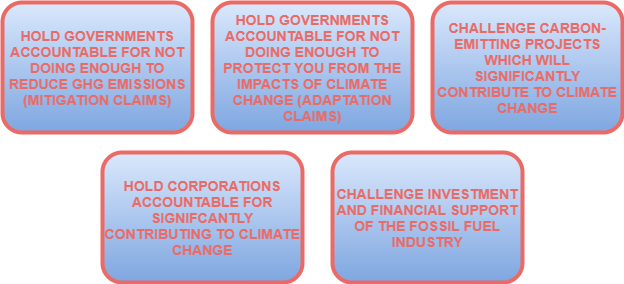Climate Change
Climate change is a huge threat to our environment, communities and the enjoyment of our human rights. The climate is changing. There is consensus among climate scientists that governments are not doing enough to combat it and that many corporations are continuing to contribute to climate change by emitting excessive amounts of greenhouse gases (“GHGs”).
But society is not powerless. There are options for us to fight for climate justice. One of these options is climate litigation. Climate litigation means legal action that aims to combat climate change and involves arguments which are related to climate change.
This is a step-by-step guide designed to introduce you to a range of legal responses to climate change and help you think about which response may be right for you, your organisation or community. In particular, it provides guidance on taking legal action to:

The Scope and Purpose of the Action4Justice Climate Litigation Guide
This Guide is designed to help you think about whether climate litigation is right for you. It provides an introduction to different types of claims you could bring, legal strategies that could help you bring such claims, and highlights organisations and other resources that could help. You can also find a PDF copy of the Guide here.
The Guide is not a substitute for legal advice.
This Guide is general in scope. It looks at examples of laws and cases in different countries, outlines legal developments and provides general tips on legal strategy.
To bring a case, you have to know the law and legal system in your country.
If, after reading the Guide, you want to explore the possibility of taking climate litigation further, seek a lawyer or an organisation that could help you develop your case.
What Is Climate Change?
Climate change refers to the changes in climate because of the increase in the average global temperature. Temperatures have naturally risen and fallen throughout history. What is different about climate change is that there is a trend of temperatures continuing to rise, and this trend is not caused by natural causes.
So far, the average global temperature has risen 1.1°C in the last century. Climate scientists say this will continue to rise unless we take action. 1.1°C may not sound like much, but it has big environmental and human consequences.
(a) What Are the Causes of Climate Change?
Certain gases in the atmosphere, such as carbon dioxide (CO2), methane, nitrous oxide and chlorofluorocarbons (CFCs), create what’s called the “greenhouse effect”.
- Heat from the sun is supposed to hit the Earth through radiation, warming it;
- Some of the heat is then released back into space; and
- Some of the heat stays in the atmosphere. This is because greenhouse gases (GHGs) act as a thermal blanket for the Earth, absorbing heat and warming the surface to a life-supporting temperature.
GHGs are natural and have an important function. The problem is that human industrial activity has resulted in an unnaturally high level of GHG emissions.
- The burning of fossil fuels (i.e. coal, oil and gas) as fuel for cars, factories, machines and planes creates excess levels of CO2 in the atmosphere;
- Intensive meat and dairy farming create excess levels of methane in the atmosphere; and
- The cutting down of trees and destruction of ecosystems reduces the Earth’s ability to capture GHGs.
This unnaturally high level of GHGs in the atmosphere creates a more intense greenhouse gas effect. Too much heat from the sun becomes trapped in the Earth’s atmosphere instead of being released into space. This leads to global temperatures increasing over time.
(b) Is Climate Change Really Happening?
Yes. It is now almost universally accepted that climate change is happening.
- At least 97% of scientists globally agree that the Earth’s temperature is rising, and human activity plays a central role.
- The IPCC’s Fifth Assessment Report (AR5), concluded that there’s a more than 95% probability that human-produced GHGs have caused much of the increase in Earth’s temperature.
Courts are very likely to accept the main scientific findings of the IPCC as the generally accepted view on climate change. This is because in most cases you do not have to prove something is absolutely certain to be true or for it to be accepted as a fact. It is often enough to give evidence that something is more likely than not for it to be accepted as true in court.
What Are the Impacts of Climate Change?
Global average temperatures are rising. But this does not mean that everywhere becomes a little hotter. Different places are affected differently. There can be dangerous spikes of temperature increase in different seasons, and even small temperature increases can have major impacts on our ecosystems and human life.
The IPCC concludes that damages resulting from climate change are likely to be significant and to increase over time. The impacts of climate change include:
- Temperature extremes, such as increasingly frequent and severe heatwaves;
- Changes in patterns of rainfall, leading to more floods, landslides and droughts;
- Rise in sea levels, leading to flooding of coastal areas;
- Melting of permafrost, snow, ice and glaciers, leading to flooding and release of GHGs; and
- Air pollution severely impacting the health of your family and community.
These effects have severe impacts on human life, including:
- Food and water shortages;
- Threats to physical health and survival;
- Loss of property and home; and
- Loss of way of life and cultural survival.
Key Resource: WHO Report – Quantitative risk assessment of the effects of climate change on selected causes of death, 2030s and 2050s
This is the latest of the World Health Organisation’s assessments of the health impacts that climate change is projected to have. The assessment concludes that climate change is expected to cause approximately 250,000 additional deaths per year between 2030 and 2050; 38,000 due to heat exposure in elderly people, 48,000 due to diarrhoea, 60,000 due to malaria, and 95,000 due to childhood undernutrition.
While climate change is a global problem, it’s important to note that its impacts are local and vary, affecting some regions and peoples much more than others:
- Children, indigenous peoples, women and the global poor are particularly affected; and
- Island nations, coastal countries and countries closer to the equator will be badly affected.
Can We Do Anything to Stop Climate Change?
YES. There are practical and affordable ways to do this.
(a) What Needs to Be Done?
The IPCC has concluded that we can substantially reduce the risk of dangerous climate change if we limit global warming to 1.5°C above pre-industrial levels. If temperatures rise by over 1.5°C and especially by 2°C, there is a risk the impacts will be irreversible, uncontrollable and severe. BUT it should be underlined that there is no safe level of global warming. The Earth has already warmed by 1.1°C and this has led to record breaking heatwaves, forest fires and other disasters, costing human lives.
To keep temperatures to 1.5°C, countries need to immediately and substantially reduce their GHG emissions. This process of reducing our GHG emissions is called “mitigation”.
Every country has to take mitigation measures. But industrialised countries, who are responsible for most GHG emissions, have to take the most action. The IPCC has concluded that, at a minimum:
- Industrialised countries should have reduced their GHG emissions by 25-40% by 2020;
- Industrialised countries must reduce their GHGs by at least 50% by 2030; and
- Globally, we should aim for GHG emissions to reach net zero by 2050 (this means that we only produce as much GHGs as can be captured by, for example, photosynthesis in trees).
GHG emissions can be reduced in a variety of different ways, and countries have some flexibility in what mitigation measures they take. But the following actions are fundamental:
- Immediately reducing (and eventually stopping) the amount of coal, oil and gas we take out of the ground;
- Transitioning to renewable energy (wind power, solar power, tidal power etc) for electricity and transport, instead of burning coal, oil and gas for fuel;
- Reducing levels of intensive meat and dairy farming; and
- Stopping deforestation and rehabilitating ecosystems (forests, marshes, wetlands etc) that can capture CO2.
As we cannot avoid all the impacts of climate change, governments also need to take “adaptation measures” to protect people from climate impacts. This includes building flood defences and developing drought resistance crops.
(b) What Have Countries Done?
Climate change is a global problem and can only be solved by global action. One of the main ways the world has reacted is by creating international climate change agreements.
The United Nations Framework Convention on Climate Change (UNFCCC)
This was the first international agreement on climate change. It sets the global framework for negotiations on climate change and 197 countries are parties. It contains general obligations for countries to:
- Take mitigation measures to avoid dangerous climate change; and
- Take adaptation measures to protect impacted communities.
But, as a framework convention, its commitments are general to permit adjustments over the years as scientific evidence, understanding and political will evolves.
The UNFCCC also paved the way for yearly negotiations, called the Conference of the Parties (COP), where more specific agreements can be reached.
This is the most recent climate change agreement under the UNFCCC. Its key features are:
- It sets an objective of limiting global temperature rises to well below 2°C, while pursuing efforts to limit temperature rise to 1.5°C;
- All countries have an obligation to reduce their GHG emissions; and
- Countries have to submit nationally determined contributions, which detail countries efforts to reduce GHG emissions.
(c) Are We Doing Enough?
No. While some countries are starting to take mitigation measures, we are not close to reducing our GHG emissions to the extent that science tells us we need to avoid dangerous climate change.
- Some countries haven’t made strong enough commitments to take mitigation measures.
- Other countries have made commitments but don’t take enough action to make these commitments a reality.
Key Resource: United Nations Environmental Program Emissions Gap Reports
UNEP releases annual reports which compare the actual GHG emissions reductions with the GHG emissions reductions we have to make to avoid temperature rises of 1.5°C and 2°C.
- It considers different scenarios and makes projections on the basis of current policies.
- It also outlines the level of GHG emissions reductions that need to be made each year to avoid dangerous climate change.
UNEP’s latest report has outlined that countries’ current GHG reduction commitments will only deliver a third of the reductions needed to limit global warming to 1.5°C.
Governments and corporations need to act fast. Climate litigation is one way of trying to get governments and corporations to take the necessary steps to avoid dangerous climate change. This Guide will now take you through the options you have and the steps you need to take to use legal action to combat climate change.
Contributors
The A4J Climate Change Guide was authored and prepared by:
- Hannah Blitzer – PHD Candidate at the University of Sussex
- Joshua Jackson – Project Manager at A4J, Pupil Barrister at Cloisters Chambers
- Richard Lord Q.C. – Chair of the Governance Group at A4J, Queen’s Counsel at Brickcourt Chambers
A4J would also like to thank the following persons for their contributions in reviewing the Guide:
- David Estrin – Certified Environmental Law Specialist, Adjunct Professor at Osgoode Hall Law School, Toronto
- Jennifer Gleason and Killian Doherty – U.S. Office of the Environmental Law Alliance Worldwide (ELAW)
- Marc Willers Q.C. – Garden Court Chambers, London
- Ingrid Gubbay – Head of Human Rights and Environmental Law Disputes at the law firm of Hausfeld Global
- The legal team at Greenpeace International
![]()



